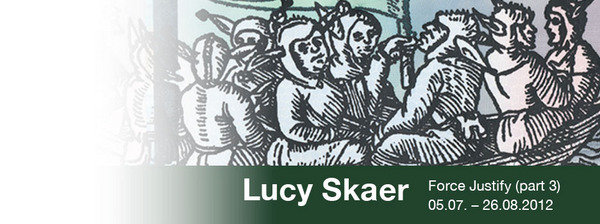Lucy Skaer
dal 3/7/2012 al 25/8/2012
Segnalato da
3/7/2012
Lucy Skaer
Kunsthalle Wien Project Space, Wien
Force Justify. Skaer employs drawing, 16-mm film, and sculpture as her media, combining them in manifold ways to create room-spanning installations. Her mark making provides a striking contrast to the subjects she deals with, such as physical violence in the exercise of structural power and conflicts between order and chaos or reason and irrationality, and to the critical examination of the heritage of history and its recording.

curated by Cathérine Hug
Introductory words: Diana Baldon (Director of Index – The Swedish Contemporary Art Foundation, Stockholm) on the
artist and Cathérine Hug (curator Kunsthalle Wien) on the exhibition
Lucy Skaer alternately employs drawing, 16-mm film, and sculpture as her media, combining them in manifold ways
to create room-spanning installations. Her mark making provides a striking contrast to the subjects she deals with,
such as physical violence in the exercise of structural power and conflicts between order and chaos or reason and
irrationality, and to the critical examination of the heritage of history and its recording. Lucy Skaer describes her
subtle treatment of the factor time with an analogy capturing the intensity of the moment that plays a crucial role in
her work: “Some works of art seem to inhabit the present time. They play out the same temporal dynamic as
catching someone’s eye on the subway and holding it for a little too long.”
The exhibition Force Justify (part 3) conceived for Vienna is a sequel to, and extension of, her presentations at K21 in
Düsseldorf (2010) and at Tulips & Roses in Brussels (2012). At each station, several elements relating to the specific
site and its environs have been added to the multi-part room-spanning installation. The show’s thematic pivot is an
allegory: the moral satire Ship of Fools (Daß Narrenschyff ad Narragoniam) by Sebastian Brant (1457–1521), which
was printed in Basel in 1494 and is regarded as the most popular German language book of the Reformation period.
The work unfolds a typology of more than one hundred different fools on a ship – a motif spread widely in a large
number of woodcuts and other contemporary prints. It is the title page of the edition published by Wendelin Rihel in
Strasbourg in 1549 blown up several times that Lucy Skaer makes the center of the exhibition. Brant’s work may be
read both as a social study and as a warning and instruction against moral misbehavior. The inspiring text has been
repeatedly drawn on in the history of European civilization and was critically assessed by such different and influential
persons as the painter Hieronymus Bosch (1450–1516), a contemporary of the author, and the philosopher Michel
Foucault (1926–1984).
As with the large print, the sculptures, titled The Good Ship Blank and Ballast (2010–2012) have undergone a
transformation. First exhibited in Dusseldorf in 2010, they originally consisted of ninety-eight aluminum sculptures
which were free interpretations of Newborn (version I, 1920, MoMA, NYC), a work by the famous Romanian-born
artist Constantin Brâncusis (1876–1957). Brancusi’s sculpture, chosen by Skaer for its quality of moving between
representation and plain matter, has now been melted down and recast in to columns that are made to match the
patterned floor of the space of Tulips and Roses in Brussels. According to Skaer, the word “ballast” refers to objects
that spring from a purely functional context. They provide weight and stability and lack any representative of specific
quality whatsoever.
Asked how the individual elements of a larger context are related to each other in her work, Lucy Skaer says, “The
work often devises systems of representation which then come under scrutiny and teeter on the verge of collapse. In
this installation, I am working with an idea of the collective subjective position. Fools who do not understand one
another or share a common vision, cast adrift together and observed from the outside. This position is a challenge to
language and meaning, and systematic thought is more or less abandoned . . . The show at KUNSTHALLE wien
karlsplatz provides the opportunity to accumulate the parts so far, and make them more extreme. For example, the
print which I made in Vienna is taken from a woodcut which I first carved into the floor in Dusseldorf. When first
carved, the image was whole and recognizable. The floor has now been removed from the museum in Dusseldorf
and is reassembled, but in a scrambled form. Each print taken from the printing block will be further and further
scrambled until it is completely unreadable . . . The Fool is in a way an alter-ego for the artist, and the choices made
by the Fool have to do with immediate material satisfaction, with making something pleasing, even if this entails
wilfully misusing it.”
Lucy Skaer born in Great Britain in 1975, lives and works in New York. In 2007, Skaer, still in her early thirties, Skaer,
featured her work in the Scottish Pavilion at the 52nd Venice Biennale. She was shortlisted for the prestigious Turner
Prize (Tate Britain) next to Enrico David, Roger Hiorns, and Richard Wright in 2009.
Opening in the presence of the artist: Wednesday, July 4, 2012, 7 p.m.
Kunsthalle Wien Project Space
Karlsplatz, Treitlstrasse 2, Wien
Hours: Tue – Sat 1:00 a.m. to midnight, Sun and Mon 1:00 a.m. to 7:00 p.m.
Free admission



